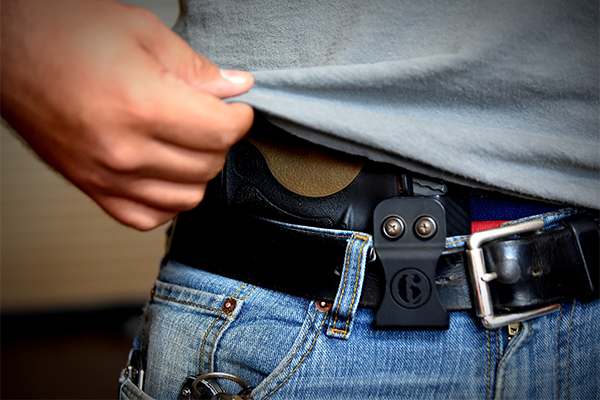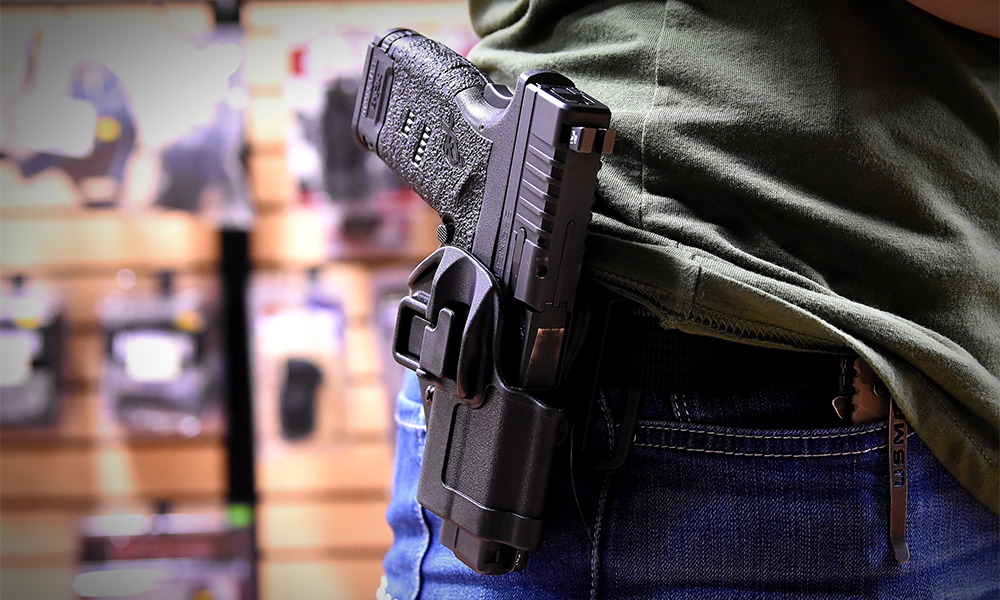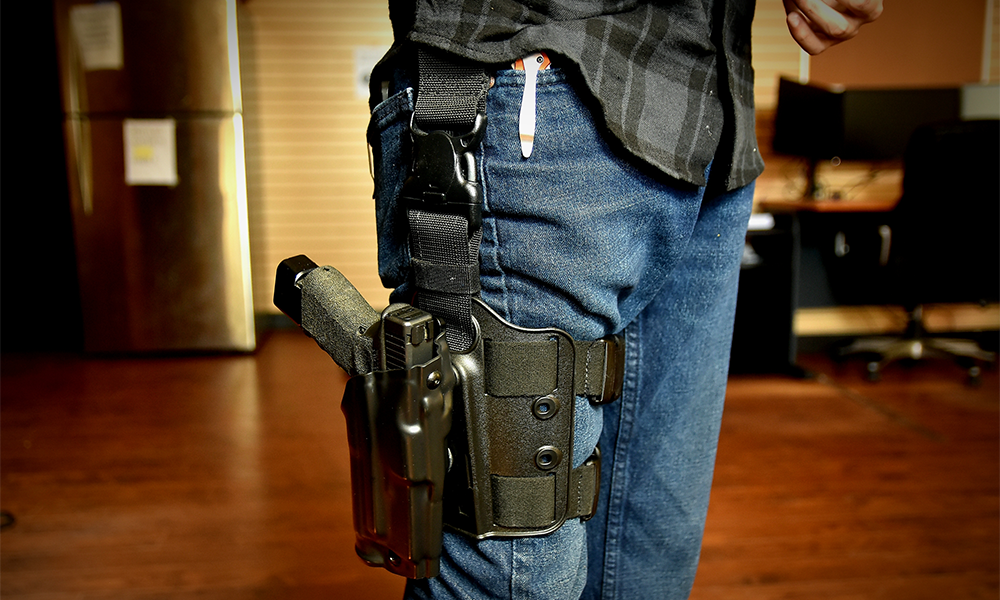
Last Updated on
By Vic Laboy
Finally, your time has come. You’ve aced your qual and submitted your documents, and now you’re waiting for your permit to arrive. Since you are legally permitted to publicly carry your firearm, the question arises: “Should I conceal or open carry?” Some states allow both carry methods blanketed under a single permit, like Texas. As of January 1st, 2016, concealed handgun license holders were granted the right to openly carry their pistols. Now referred to as a license to carry, or LTC, you may carry your pistol either concealed underneath your clothing or in a holster resting outside the waistband. Like anything we face, there are both positives and negatives to each method. Let’s weigh both options below.
The Pros of Open Carry
Open-carry is defined as the act of carrying your pistol in an exposed manner. Most companies offer outside the waistband configurations, also known as OWB. The immediate benefit is it acts as a deterrent. While most do not wish to initiate conflict with an individual with a blatant advantage, this does not empower you over your peers. Another advantage you gain from OWB setups is a comfortable carry method. Unlike inside the waistband (IWB) holsters, you are not constantly jabbed in the side by your concealed pistol. Companies like BLACKHAWK! configure their holsters to rest an inch or so from the waistline. Not only do you gain comfortability, it is considered a more “rapid deployment” option as well. Since you do not have to clear your garment, the only concern is gripping the pistol and drawing down on your target.

This technique also allows you options that are otherwise unavailable with other forms of carry. For instance, most OWB holsters include level II and level III retention. To break this down, level II utilizes retention along the trigger guard that is disengaged by a single release, like the BLACKHAWK! Serpa Level II. Once this button is pressed, the catch inside the holster unblocks the firearm allowing a smooth and easy draw. Level III retention uses the same feature as the level II as well as a hood which is disengaged by a thumb release. This is commonly found among law enforcement and military with stricter regulations pertaining to their duty rigs.
Lastly, it is easier to find a light-bearing holster with adequate retention levels. Companies like Surefire, Streamlight, and Inforce provide options for almost every pistol on the market. As a result, companies are required to keep up with the demand for holsters that can support a weapon-mounted light (WML). We all know the struggle of mounting a WML but being unable to carry due to your holster not supporting this setup. Not only is there an array of options, the bulkiness of the setup is rarely a concern as concealment is not the goal with OWB holsters.
The Dark Side of Open-Carry
Despite having a few great advantages, open carry comes with its disadvantages. The first and more obvious being the loss of the element of surprise. There is no mistaking a holstered weapon that rests either on your hip or thigh with dropleg holsters. While this may give you a tactical advantage when presenting from the hip, a threat that enters a building may initially target you as you are their greatest adversary.
A less common yet still negative aspect to open carry is you gain a larger profile. Entering a room or vehicle may lead your holster to unintendedly snag on foreign objects depending on how far the pistol rests on your hip. Even though the chances of this occurring are slim, it is a risk you face with this form of carry.

Advantages to Concealed Carry
Carrying concealed allows you to maintain a non-threatening appearance and does not alert passerby’s that you are carrying a firearm. The act of concealed carry is classified by your ability to mask your pistol under your clothing. This not only prevents arousing suspicion, but also gives you the element of surprise as you go about your daily tasks. When properly executed, the odds of a nearby stranger locating your weapon are slim to none. With the appropriate attire, a concealed pistol goes virtually unnoticed yet remains ready in a moments notice.
Most companies also offer concealed holsters which allow you to carry your firearm comfortably hidden under your clothing. Due to the high demand and diversity of the market, each manufacturer must determine what their options provide. While 1791 Gunleather focuses primarily on comfort, they lack the retention levels of an Aliengear holster or others that utilize passive retention. This form of security acts in the same way as the Level II Serpa by BLACKHAWK! in that a ridge within the holster secures around the trigger guard. However, this differs with IWB as the retention is defeated solely by pulling upwards from the holster to remove the weapon.
In addition to the vast amount of options, IWB allows you to carry at any position on your waistline. Imagine yourself as a clock with your immediate front being your 12 o’clock, immediate right is your 3, so on and so forth. Once you determine the best position for you personally, train with your chosen location to build proficiency and maintain effectiveness.

The Downside to Concealed Carry
For beginners, Concealed Carry may seem uncomfortable from the start. Not everyone is accustomed to having a chunk of steel resting between their skin and pants. Do not allow this to deter you from carrying your pistol, which renders your carry permit useless. Over time, you will adapt to the change and find yourself unable to leave the house without your carry weapon. Additionally, menial tasks like picking up a pen that fell from your desk may take some getting use to. Those who carry at a 12 o’clock appendix know this all too well.
Those more inexperienced may also worry themselves with the concern of their CCW being exposed. This is a battle each of us faced when first stepping foot into the world with our new responsibility as a licensed firearm owner. The tendencies include constantly adjusting your waistline to gain a more comfortable position or tugging the bottom of your shirt to make sure you’re covered. Even though your handgun is tucked under your shirt, your mind tricks you into thinking otherwise. The stress is only heightened as first-timers are concerned with the fact that everyone around them is immediately aware that you are carrying.
Not only must you alter the way you perform the most miniscule tasks, it requires a bit more training to successfully present from concealment. Unlike open carry holsters where you merely reach down and disengage any active retention settings, conceal carry forces you to take additional measures to eliminate a threat. For example, you must ensure you clear your garment well enough to secure a proper grip on the firearm to present the pistol to the ready position. There are many steps to follow, and it is imperative that you train properly and consistently so that it becomes second nature. Hesitation can cost you your life and is easily prevented through time and practice.
Final Regards
Please remember that when selecting a carry method, it is up to you to determine what feels best. The person next to you may feel comfortable using an entirely different option than yours and that is acceptable. Once you have determined the right fit, check out our online store or peruse the aisles of our retail store in Arlington, Texas where one of our associates will be happy to assist you!




Leave a Reply